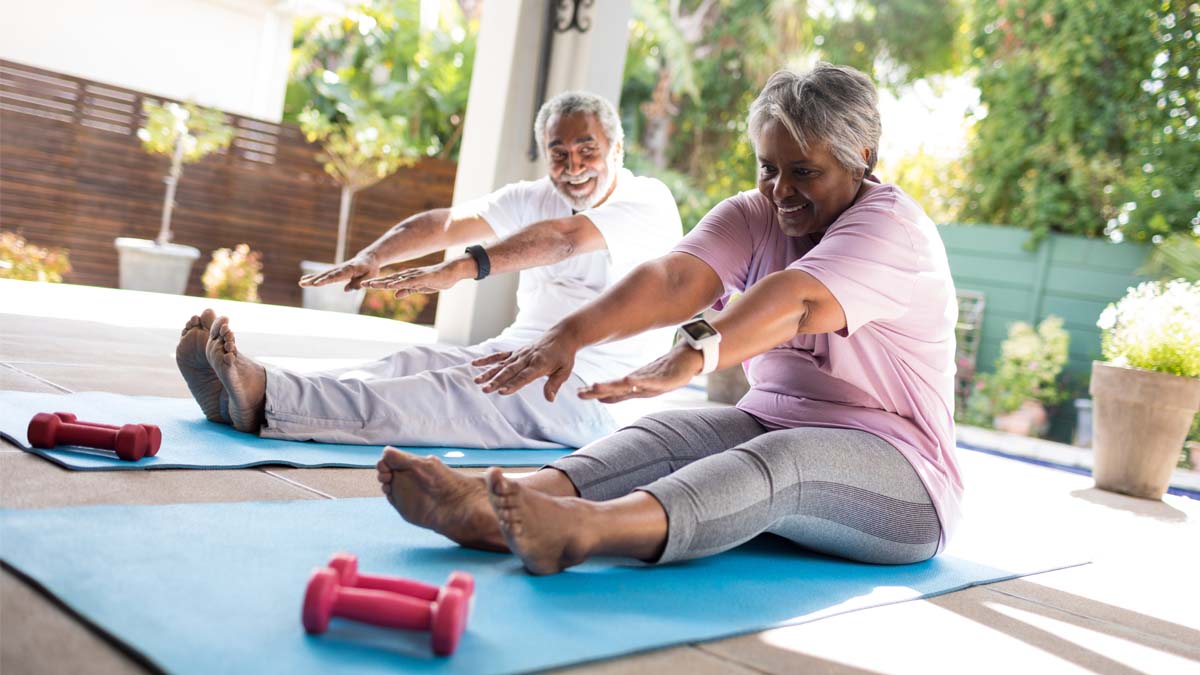Stretching — you don’t need special clothing. You don’t need any gear. You can do it indoors or outdoors at your own pace. And, yet, stretching and flexibility may be the most overlooked and underrated elements of a healthy lifestyle.
Flexibility allows us to get more out of our other workouts and can help us do basic things around the house, like reaching a high shelf, bending when unloading the dryer, or squatting while gardening. Flexibility has also been associated with stress reduction and mental and physical relaxation.
“Flexibility is the ability of your muscles and other soft tissues to move your joints,” explained Kim Durst PT, DPT, physical therapist and clinical director at Axis Physical Therapy. “Joint range of motion is the flexibility of those soft tissues, basically how well the joint is performing. Each joint has a normal range of motion, although it varies by individual.”
“Research has shown that both men and women lose range of motion as they age,” Durst said. “Our muscles and other tissues become less elastic. But range of motion can be even more diminished in certain circumstances like when someone is dealing with an injury or arthritis. When someone experiences pain, a significant loss of motion may occur, and once a joint moves less, it will adapt to that smaller range of movement.”
A sedentary lifestyle has the same affect. When someone is sitting in a chair all day, or not devoting enough time to physical activity, it can also lessen flexibility over time. According to the American Heart Association, flexibility exercise is one of the four types of exercise along with strength, balance, and endurance. Ideally, a healthy workout routine would include all four types of exercise.
Fortunately, there are loads of activities that involve stretching that can easily be introduced into your routine. You might try yoga, Pilates, dance, gardening, tai chi and other martial arts and even some types of housework.
Caroline Nash, registered yoga teacher and owner of Community Yoga in Charleston, knows the stunning effects that yoga can have on a participant’s flexibility as well as their overall physical and mental health.
“In yoga, a person might come to get their body moving again, but they often find that they release a lot more than their tight joints,” Nash explained. “Although you might be working on loosening a tight hip, your whole body may start to relax, and you may find a sense of peace during a class,”
“Yoga is a practice going back thousands of years and has had a profound effect on many people from different backgrounds and cultures,” she added.
“Stretching in yoga can be described as either yin or yang,” Nash eexplained. “Yin yoga techniques focus on holding a pose for about three to five minutes in a supported way, sometimes with a pillow or blocks, and focusing on breath. Yang yoga is more dynamic, focusing on strength and movement.”
These techniques work on improving flexibility in multiple ways.
Durst emphasizes to her patients that working on flexibility will have a huge impact on their health. “It’s never too late to slow down the loss of flexibility,” she noted. “Wherever you are, work to keep what you have. Although you might gain some function, it is way easier to keep the flexibility you have, than gain it back.”
A panel of experts convened by the American College of Sports Medicine reviewed a wide range of studies to look at how individuals should incorporate flexibility into their activity. Based on the evidence, the panel agreed that healthy adults should do flexibility exercises for all major muscle-tendon groups — neck, shoulders, chest, trunk, lower back, hips, legs and ankles — at least two to three times a week.
The type and intensity of these activities will vary by individual. A person should always check with their health care provider if they have concerns about exercise or are feeling any significant pain.
Hank Kearse has been incorporating stretching into his exercise routines for years. He currently works with MUSC Wellness Center trainer Jerimiah Spires and range of motion is one area they focus on.
“Stretching is always a part of my workout, whether by myself or with a trainer,” he said. “I usually use a foam roller to start and then work on some more active stretching like front and side kicks and sometimes using a resistance band.” He adds, “As part of a cool down, I do more static stretching, like leg extensions and hip stretches.”
Alicia O’Connor is an exercise physiologist and the director of personal training at MUSC Wellness Center and works with participants like Kearse that have made a commitment to maintaining or improving their flexibility.
“It’s important to establish good habits when you’re younger so that you will have more mobility as a senior,” said O’Connor. “It’s possible to increase your flexibility as you age if you participate in a regular stretching regimen. This increase can occur even if you have no prior history of a stretching routine. It’s key to make time for stretching and movement every day.”
Kearse said the most critical part of setting a fitness goal is to stick with it. “I noticed a loss of flexibility when I stopped working out regularly,” he said. “Having a routine is a commitment, but it pays off for sure.”
As many of us embrace a work-from-home lifestyle, it’s even more essential not to allow inactivity to result in loss of flexibility as we age. Setting an alarm to remind yourself every 30 to 45 minutes to get up and move or stretch can do wonders. Your phone alarm or one of the many mobile device reminder apps can be just the nudge you need.
Durst is confident that everyone can benefit from incorporating stretching into their routine. “If you start now, you can have a positive affect over the long run,” she said. “It can be the difference in your quality of life.”
By Lisa Wack







